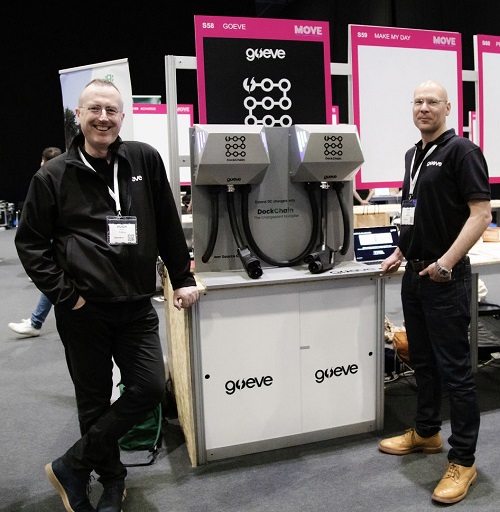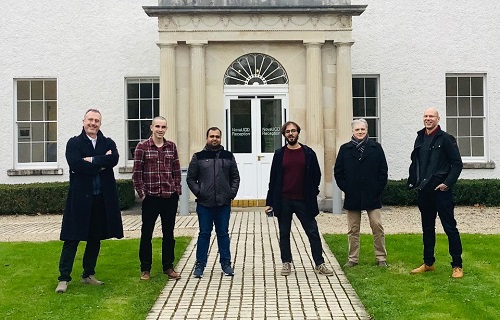
Go Eve Multiplies the Possibilities for Electric Vehicle Charging
- An ingenious solution for charging multiple electric vehicles drives the first joint startup from Imperial College London and University College Dublin
More people need to be driving electric vehicles, to mitigate climate change and reduce urban air pollution, but that is not going to happen unless access to charging becomes a lot easier. This is where Go Eve comes in, a startup with simple way of creating more charge points.
The company is commercialising a system developed initially by Professor Robert Shorten and colleagues at University College Dublin (UCD). He was an early adopter of electric vehicles, and has worked for many years on the shared economy and strategies to make electric driving more attractive in cities. In Dublin, around 2015, the main barrier appeared to be insufficient charge points to support an electric vehicle fleet.
“But if you looked at the data, that was not entirely correct,” Professor Shorten recalls. “At the time, the Irish government had a scheme that installed a charge point at your home if you bought a plug-in vehicle. So, there were a lot of electric charge points in Dublin, they just happened to be sitting in people’s driveways.”
One becomes many
His first idea was to create a device that could turn these private charge points into public ones. “And a natural extension of that was to have multiple sockets on the device, so you could plug in several vehicles and not just one.” This would also address the ‘charger anxiety’ experienced by electric vehicle drivers, then and now, where charge points are often inaccessible because other vehicles are blocking them. “The idea was to create a system whereby you don’t need to move cars to have access to the charge point.”
Unfortunately, you can’t just plug an extension cable into a vehicle charge point. Electric cars exchange information as well as power when they are charging up. The charger talks to the car, announcing that it has power to give, and the car replies that it has the capacity to accept it, on condition that this is a one-to-one relationship.
So the UCD researchers came up with a way of tricking the charger into thinking it is only ever connected to one car. Similarly, a car can be third or fourth in line on the cable, but it is told that it is connected directly to the charger. This allows the electricity to flow, and to be switched automatically from one car to the next, so that they get topped, one after the other. At no point are two or more cars charging at the same time, which makes the design easier from an electrical point of view.
The researchers built and tested a prototype, which they called DockChain, and a patent application was filed. Time passed, and in 2019 Professor Shorten moved to the Dyson School of Design Engineering at Imperial, together with two colleagues who had worked on the project: postdoc Dr Pietro Ferraro and Master’s student Andrew Cullen.

Pictured (l-r) at NovaUCD are Go Eve team members, Hugh Sheehy, Andrew Cullen, Ammar Malik, Dr Pietro Ferraro, Prof. Robert Shorten and John Goodbody
Divide and rule
The innovation remained on file at UCD until it was brought to the notice of Hugh Sheehy and John Goodbody, two entrepreneurs interested in electric vehicles. They liked notion of multiple car charging, and asked if the system could be adapted from the low-power alternating current (AC) used in domestic charging to work with the high-power direct current (DC) used for roadside charging. The answer was yes, and in early 2021 Go Eve was set up to commercialise multi-vehicle charging for fleets and locations such as office, hotel, and airport car parks.
“With DockChain, you get a high-power DC charger, with a series of terminals coming off it that look a bit like traditional AC slow chargers, but which are capable of 150-kilowatt high-power charging,” says Mr Goodbody. “That will allow you to wire a whole car park and run it off an existing high-power charger, effectively reducing the cost about 10-fold from the way people are doing it today.”
Go Eve has also developed software to offer different charging configurations for different kinds of customer. “Some people want the average charge to be raised across all their vehicles. Others want certain spaces to be designated as one-hour-only rapid charging spaces, leaving the rest to charge only as and when the power is available.”
In 2021, the company completed and was the overall winner of VentureLaunch, UCD’s dedicated accelerator programme for new startups commercialising intellectual property developed at the university.
“Go Eve’s vision is to enable rapid DC charging for parking spaces at little more than the cost of the current slow AC charging infrastructure,” says Mr Sheehy, who is now the company’s chief executive.
“To support the implementation of this vision, we are currently seeking to raise £2.5 million in seed funding to run a number of pilot programmes later this year, to further accelerate product development and to support expansion of the team, especially in the US market. We aim to have our first production chargers available by the end of 2022.”
Academic connections
For Mr Goodbody, the experience of working with the two universities has been extremely positive. “After graduating I went into industry, and I had no further connection with universities until now,” he says. “And I’m still wondering: why didn’t I? There must have been some great opportunities, ideas and innovations that I should have latched onto, 20 years ago. You guys have got the solutions we are looking for.”
And Go Eve maintains close connections with the universities, both of which are shareholders in the company. At UCD, researcher Ammar Malik is working full time on the DockChain prototype. And the three researchers now at Imperial remain involved, Professor Shorten as Head of R&D, and Dr Ferraro and Andrew Cullen as research engineers. “There are a lot of possibilities and opportunities here to do really interesting things, and we want to look into them,” Professor Shorten says.
One of these is the possibility of using electric vehicles connected to the DockChain system to store surplus power flowing into the electricity grid at moments of peak production by renewable sources. This stored power can then be fed back into the grid later on. Persuading drivers to support this approach connects with Professor Shorten’s current research on cyber-physical systems.
“Ironically, as battery capacities grow, it becomes harder to use electric vehicles in this way, because you can’t put energy into a car unless it is plugged in. So, you have to incentivise people to plug in their vehicles, even when they don’t need to charge them, so that they can absorb energy,” he explains. “The work I’ve been doing at Imperial has been focused on distributed ledgers and the infrastructure you need to employ digital tools like that, to incentivise and help orchestrate the interaction of humans and technology.”
This research fits in with Imperial’s Transition to Zero Pollution initiative, which aims to create innovative technologies and policies that go beyond single environmental problems to improve entire systems.
ENDS
30 June 2022
Written by Ian Mundell and republished here with the permission of Imperial College London.
Click here for original article.
For further information contact Micéal Whelan, Communications and Media Relations Manager, NovaUCD, e: miceal.whelan@ucd.ie.
